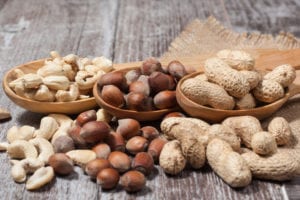Written by Taylor Woosley, Staff Writer. After adjusting for potential confounders, results of the study show that consuming 1-6 servings of nuts per week was associated with a lower risk of CKD in all models (p<0.05).
 Chronic kidney disease (CKD) is a global health problem leading to loss of kidney function and end-stage renal disease1. The international guideline defines CKD as decreased kidney function as shown by a glomerular filtration rate (GFR) of less than 60 ml/min/1.73m2, or markers of kidney damage, of at least 3 months of duration2. An estimated 37 million adults in the US have CKD which results in an increased risk of cardiovascular disease3. It is a progressive condition; 14.6% of patients with mild CKD and 16.5% with moderate CKD progress to end stage CKD, approaching the need for kidney replacement therapy4.
Chronic kidney disease (CKD) is a global health problem leading to loss of kidney function and end-stage renal disease1. The international guideline defines CKD as decreased kidney function as shown by a glomerular filtration rate (GFR) of less than 60 ml/min/1.73m2, or markers of kidney damage, of at least 3 months of duration2. An estimated 37 million adults in the US have CKD which results in an increased risk of cardiovascular disease3. It is a progressive condition; 14.6% of patients with mild CKD and 16.5% with moderate CKD progress to end stage CKD, approaching the need for kidney replacement therapy4.
Past research has shown the positive effects of certain foods on kidney function, such as consuming high levels of fiber and plant-based foods5. Plant foods are rich in phytochemicals, antioxidants, vitamins, and minerals which prove beneficial to health, especially when consumed in their unprocessed form6. Nuts are nutrient-dense foods, rich in polyunsaturated fatty acids and minerals such as magnesium, which may prevent kidney injury7. Furthermore, nut consumption has been associated with a variety of health benefits such as changes in glucose metabolism, oxidative stress, and inflammation8.
Wang et. al conducted an observational study using cross-sectional data collected from the 2003-2006 National Health and Nutrition Examination Surveys (NHANES) to assess the association between the prevalence and mortality of CKD and nut consumption frequency. Participants (n=6,072) with complete data from the Food Frequency Questionnaire (FFQ), along with demographic information and data on kidney function and cholesterol levels were included in the study. Dietary intake questionnaires were administered every 2 years of the study and included two 24-h recall interviews. Serum creatinine values, the estimated glomerular filtration rate (eGFR), and the measurement of urinary albumin and creatinine were used to establish CKD participants and subjects were further divided into groups 1-5 of CKD stages.
Study results show that consuming nuts 1-6 times per week was associated with a lower risk of CKD in all three models (model 1: odds ratio [OR]: 0.53; 95% CI: 0.40–0.70; model 2: OR: 0.52; 95% CI: 0.40–0.70; model 3: OR: 0.67; 95% CI: 0.49–0.91, p < 0.05). Furthermore, in all models, a significant inverse association existed between consuming nuts 1-6 per week and all-cause mortality (model 2: HR: 0.52; 95% CI: 0.40–0.70), p<0.001).
Overall, nut consumption 1-6 times per week was significantly associated with a lower occurrence of CKD. Higher nut consumption was also significantly associated with lower all-cause mortality in non-CKD subjects. Future studies should examine if specific nuts have greater kidney-protective and cardioprotective properties. Study limitations include the cross-sectional observation nature of the study, resulting in the inability to prove causality, the potential confounding by unknown factors, and the use of a self-assessed questionnaire which could allow for subject recall bias.
Source: Wang, Koushu, Duo Qian, Yuncan Hu, Yichun Cheng, Shuwang Ge, and Ying Yao. “Nut consumption and effects on chronic kidney disease and mortality in the United States.” American Journal of Nephrology (2022): 1-10.
© 2022 S. Karger AG, Basel
Click here to read the full text study.
Posted September 1, 2022.
Taylor Woosley studied biology at Purdue University before becoming a 2016 graduate of Columbia College Chicago with a major in Writing. She currently resides in Glen Ellyn, IL.
References:
- Nguyen HH, Tran HH, Nguyen LT, et al. TG/HDL-C Ratio Is a Risk Factor Associated with CKD: Use in Assessing the Risk of Progression of CKD. Pathophysiology. Jul 17 2022;29(3):374-382. doi:10.3390/pathophysiology29030029
- Sertsu A, Worku T, Fekadu G, Tura AK. Prevalence of chronic kidney disease and associated factors among patients visiting renal unit of St. Paul’s Hospital Millennium Medical College, Addis Ababa, Ethiopia: A cross-sectional study design. SAGE Open Med. 2022;10:20503121221116942. doi:10.1177/20503121221116942
- Wang M, Peter SS, Chu CD, Tuot DS, Chen JH. Analysis of Specialty Nephrology Care Among Patients With Chronic Kidney Disease and High Risk of Disease Progression. JAMA Netw Open. Aug 1 2022;5(8):e2225797. doi:10.1001/jamanetworkopen.2022.25797
- Donald M, Beanlands H, Straus S, et al. An eHealth self-management intervention for adults with chronic kidney disease, My Kidneys My Health: a mixed-methods study. CMAJ Open. Jul-Sep 2022;10(3):E746-e754. doi:10.9778/cmajo.20210332
- Du X, Wu J, Gao C, Tan Q, Xu Y. Effects of Resistant Starch on Patients with Chronic Kidney Disease: A Systematic Review and Meta-Analysis. J Diabetes Res. 2022;2022:1861009. doi:10.1155/2022/1861009
- Dupuis L, Brown-Tortorici A, Kalantar-Zadeh K, Joshi S. A Mini Review of Plant-Based Diets in Hemodialysis. Blood Purif. 2021;50(4-5):672-677. doi:10.1159/000516249
- Ajjarapu AS, Hinkle SN, Wu J, et al. Nut Consumption and Renal Function Among Women With a History of Gestational Diabetes. J Ren Nutr. Sep 2020;30(5):415-422. doi:10.1053/j.jrn.2019.10.005
- Calvo MS, Uribarri J. Perspective: Plant-based Whole-Grain Foods for Chronic Kidney Disease: The Phytate-Phosphorus Conundrum. Advances in nutrition (Bethesda, Md). Dec 1 2021;12(6):2056-2067. doi:10.1093/advances/nmab066
